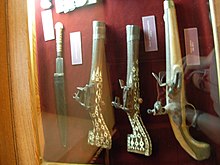A dragon is a shortened version of blunderbuss, a firearm with a short, large caliber barrel which is flared at the muzzle and frequently throughout the entire bore.[1][2] Dragons were typically issued to dragoon cavalry, who needed a lightweight, easily handled firearm to use while mounted.[3]


Etymology
editThe term dragon is taken from the fact that early versions were decorated with a carving in the form of a mythical dragon's head around the muzzle; the muzzle blast would then give the impression of a fire-breathing dragon.[2]
History and description
editEarly dragons were short wheellock firearms. It is called a dragon because the muzzle is decorated with a dragon's head. The practice comes from a time when all gunpowder weapons had distinctive names, including the culverin, serpentine, falcon, and falconet.[4] The dragon was effective only at short range, lacking accuracy at long range.[1][2]
In the Nusantara archipelago, the weapon is called a tarkul, terakul, or terakol,[what language is this?] and seems to have been preferred by cavalry due to its size. The term may refer to a blunderbuss in pistol form, but can also refer to the flintlock musket.[5]: 211 [6]: 5 They used a flintlock mechanism, and might be derived from Dutch flintlocks which entered the area in the 17th century.[7]: 64 However, it is possible that this weapon was only popular among local warriors in more recent times — the terakul was only recorded in Tuhfat al-Nafis from the 1860s.[8][5]: 211–212 The manuscript mentioned that Bugis troops with chain mail and armed with terakul pemburas (dragon-blunderbusses) defeated Raja Kechil's troops armed with cannons and swords in 1721 CE.[9]: 318
See also
editReferences
edit- ^ a b Sibbald Mike Lier (1868). The British Army: Its Origin, Progress, and Equipment. Cassell, Petter, Galpin. pp. 33, 302–304.
- ^ a b c George Elliot Voyle, G. de Saint-Clair-Stevenson (1876). A Military Dictionary. W. Clowes & Sons. pp. 43, 114.
- ^ Charles Francis Hoban (1853). Pennsylvania Archives., page 324, from a letter dated March 7, 1778
- ^ p. 333, Bismark
- ^ a b Ismail, Norain B.T. (2012). Peperangan dalam Historiografi Johor: Kajian Terhadap Tuhfat Al-Nafis. Kuala Lumpur: Akademi Pengajian Islam Universiti Malaya.
- ^ Wan Hasbullah, Wan Mohd Dasuki (4 April 2019). Istinggar dalam Manuskrip Melayu: Tradisi Ilmu dan Teknologi Minangkabau. Pusat Dagangan Dunia Putra (PWTC), Kuala Lumpur. A workshop paper in Wacana Manuskrip Melayu Siri 1 (2019).
- ^ Wan Hasbullah, Wan Mohd Dasuki (2014). "Manuskrip Ilmu Bedil Sebagai Sumber EtnosejarahTeknologi Senjata Api Melayu". Kemanusiaan. 21 (1): 53–71.
- ^ See information about Tuhfat al-Nafis in Malay Concordance Project.
- ^ Winstedt, R. O. (1932). "A Malay History of Riau and Johore". Journal of the Malayan Branch of the Royal Asiatic Society. 10 (2).
Further reading
edit- von Bismark, Graf Friedrich Wilhelm (1855). On the Uses and Application of Cavalry in War from the Text of Bismark: With Practical Examples Selected from Ancient and Modern History. North Ludlow Beamish (translator). London: T. & W. Boone. Retrieved 2014-02-01.